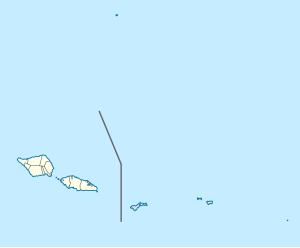Safotu
Safotu | |
|---|---|
Village | |
 Historic Catholic church in Safotu, 2007 | |
| Coordinates: 13°27′10″S 172°24′13″W / 13.45278°S 172.40361°W | |
| Country | |
| District | Gagaifomauga |
| Population (2016) | |
• Total | 1,270 |
| Time zone | -11 |
Safotu is a village on the central north coast of Savai'i island in Samoa. Safotu is in the district Gagaifomauga and has a population of 1270.[1] Traditionally, it attained the status of 'Pule,' customary political authority, and has been the main centre of the Gagaifomauga district.[2]
Safotu is also associated with the chiefly matai Ao title of Lilomaiava.
The village is situated by the sea with a district hospital and school at the west end. The hospital sits upon a small rocky rise of black volcanic rock. The main island road passes through the village and there are several churches and local stores. A turnoff from the main road leads to the inland village settlement of Paia. Safotu is about 46 km from Salelologa and the ferry terminal. The popular tourist destination Manase village is the neighbouring village to the east. Heading west past the village is Samauga followed by Lefagaoali'i and Safune.
Geography
[edit]Safotu is situated on a coastal strip at the west end of a volcanic escarpment approximately 50 m high that runs down to the coast. The coastal strip extends inland rising steadily towards Mt Matavanu. Atuimo Point is a rocky headland forming one end of Safotu beach. The lagoon varies from 300m - 400m in width along the coast with small reef breaks off the shore.[3]
There are small freshwater springs surfacing along the shore and some of these are contained as village pools at the western end of Safotu beach.
Pre-history
[edit]In pre-history, Safotu was a settlement for Tongans Talaaifeii was the name of one of the Tongan chiefs.[4]
Mythology
[edit]There are different stories about the origin of the name Safotu.
- In Samoan mythology Safotu and Safune were named after Fotu and Fune, the children of Lafai.
- The name Safotu goes back to the name of a girl Fotuisamoa, a sister of Ututauaofiti.[5]
- Safotu and other villages in Savai'i (Matautu, Sataua, Salega) were founded by the children of Laufafaitoga who was the daughter of the Tui Tonga. Laufafaitoga's husbands were Tupa'imataua of Samoa and Lautala of Fiji.[6]
- Laufafaetoga went to Samoa and became pregnant to Tupaimatuna. They sailed for Tonga but were blown off course and landed in Fiji. Their child was born and given the name Vaasilifiti. At this time, Fiji was in continual warfare and Lautala was the most famous warrior. Laufafaetoga and Lautala had three children. The first was named Ututauofiti who established the village of Matautu (where Fagamalo is situated). The second child was named Tauaofiti and he founded the village of Sataua. The third child, a girl named Lelegaotuitoga founded the village of Salega. Laufafaetoga ran away and returned to Tupaimatuna. She became pregnant again. The child was born before landing and was given the name Fotusamoa, hence the beginning of Safotu.[7]
References
[edit]- ^ "Census 2016 Preliminary count" (PDF). Samoa Bureau of Statistics. Retrieved 11 September 2021.
- ^ Soʻo, Asofou (2008). Democracy and custom in Sāmoa: an uneasy alliance by Asofou Soʻo, p.12. Retrieved 26 October 2009. ISBN 9789820203907.
- ^ "Coastal Infrastructure Management Plan(2002) Government of Samoa" (PDF). Archived from the original on 2012-12-09.
{{cite web}}: CS1 maint: bot: original URL status unknown (link) - ^ Turner, George (August 2008). Samoa a Hundred Years Ago and Long Before by George Turner, p. 193. ISBN 9780554270746.
- ^ Krämer, Augustin (1994). The Samoa Islands: Constitution, pedigrees and traditions by Augustin Krämer, p.74. ISBN 9780824816339.
- ^ Meleisea, Malama; Meleisea, Penelope Schoeffel (1987). Lagaga: a short history of Western Samoa by Malama Meleisea, Penelope Schoeffel Meleisea, p. 42. ISBN 9789820200296.
- ^ "An Account of Samoan History up to 1918 by Te'o Tuvale, p.6".


